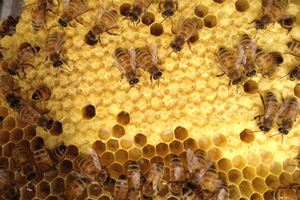- All-In-One Beekeeping for the Bees
- +1-608-728-8233
- info@beepods.com
Pesticides and Bees

aerial view of a crop duster or aerial applicator, flying low, and spraying agricultural chemicals, over lush green potato fields in Idaho.
 Pesticides. It’s kind of a loaded term. Before we dive into how they interact with bees and what you can do about it, let’s break down exactly what a pesticide is. To start, the word itself. Pest = nuisance, annoyance, thing-you-want-to-get-rid-of; cide = kill. Following that, the FDA description of pesticides as any substance or mixture of substances intended to kill pests makes sense. Where this gets tricky, is that there are different kinds of pesticides that all people can lump together confusingly. Herbicides, for example, kill plants, and fungicides kill fungi.
Pesticides. It’s kind of a loaded term. Before we dive into how they interact with bees and what you can do about it, let’s break down exactly what a pesticide is. To start, the word itself. Pest = nuisance, annoyance, thing-you-want-to-get-rid-of; cide = kill. Following that, the FDA description of pesticides as any substance or mixture of substances intended to kill pests makes sense. Where this gets tricky, is that there are different kinds of pesticides that all people can lump together confusingly. Herbicides, for example, kill plants, and fungicides kill fungi.
The most common kind of pesticides you’ll run into when people are talking about bees are insecticides, which, going by the naming conventions we’re working with, kill insects. On its face, how pesticides interact with bees seems obvious. Bees are insects after all, so the problem must be that insecticides farmers use catch some bees in the crossfire. The reality, however, is a lot more complicated – and potentially catastrophic.For the rest of this blog, I’m going to go over some of the common ways pesticides are used, how their use affects honey bees, and what you can do about it.
How Pesticides Are Used
People use pesticides in a whole bunch of ways. For our purposes, I’m going to focus on two kinds of pesticides: the insecticides in the neonicotinoid family (called neonics), and the herbicide dicamba.
Neonics
The former is applied to a massive amount of agricultural products every year. Almost every corn and soybean seed will be coated with neonics. That’s part of how neonics are different from the stereotypical pesticide people might picture when they hear the term. Instead of being dropped from a low-flying biplane like in North by Northwest, neonics are coated over a plant’s seeds before they’re planted. Then, as the plant grows, neonics will spread with it, so every part of the crop will end up suffused with a compound that’s deadly to the kind of grubs and other insects that nibble away at them (and agribusiness’ profits).
Dicamba
Farmers apply dicamba in one of two ways: they soak the soil with it before planting, or they spray it across a field to combat weeds. There are all sorts of complicated reasons for why someone might use either method, involving GMOs, megacorporations, and glyphosate (another pesticide) resistant weeds – but the long and short of it is that dicamba is supposed to specifically kill broadleafed weeds while leaving crops undamaged. Dicamba’s weird. It soaks into its targets and tricks them into basically killing themselves by confusing their chemical signals. It’s usually deployed as part of a mixture with a bunch of other pesticides. Companies design these coattails to provide maximum efficiency at killing anything that might be resistant to individual substances. So, we have our two pesticides. The next question is: how do they affect honey bees?
How Pesticides Affect Honey Bees
Neonics
Well… they kill them. Let’s go over how. Neonics work by shutting down the nervous systems of insect they contact. The real bad news is that bees are even more vulnerable because they have more of the specific receptors that neonics target than other insects. Any time a honey bee forager comes across a plant that someone treated with neonics they’re at risk of getting infected and dying.
Another reason they’re so dangerous to bees is the sublethal effects. What that means is that even if neonics don’t immediately kill the bees, there can be long-term effects that can end up seriously damaging or destroying hives anyway. If there are neonics in the pollen, for example, low levels exposure can affect the rest of the hive. This can mess up their foraging, make them grow up weaker, or a whole host of other issues. A hive is basically a superorganism; undermining one part of it can bring the whole thing crashing down.
And all of that is assuming the neonics are actually used correctly and not improperly like what happened in Germany and killed millions of bees. The European Union banned neonics, in part because of incidents like that. With the obvious culprit out of the way, let’s look at how a herbicide can be just as dangerous to bees as insecticides.
Dicamba
The surface level issue is that dicamba may be toxic. Results are inconclusive about just how dangerous dicamba is to bees directly, but that’s not the biggest problem. The biggest problem is pesticide drift. You see, when people apply dicamba to leaves it has a nasty habit of “drifting” which essentially means floating from where farmers originally applied it to other areas, sometimes miles and miles away. When you get a weedkiller like dicamba drifting that far from where it’s supposed to be, the results can be disastrous. The EPA specifically approved dicamba for use as a pesticide on genetically modified soybeans that Monsanto altered to be immune to its deadly properties. Other plants aren’t so lucky. Dicamba drift has carved a swath of destruction through non-immune crops, and has had a similar effect on bee populations.
The problem is that dicamba kills some of the most important plants that bees rely on. Broadleaf weeds, which include dandelions, clover, and chickweed among others, and are vital sources of pollen and nectar. Spreading dicamba essential starves out nearby hives. There are a lot of moving parts in our ecosystem, and upsetting one sends shockwaves through the rest. Commercial beekeepers in Arkansas have reported drops in honey productivity of up to 50% in areas near where farmers deployed dicamba. When dicamba kills local, wild sources of pollen, honey bees have nowhere to go for the resources they need. And if it turns out dicamba is toxic to bees, the bad news is that it sticks around for a while. Pesticides, not just insecticides, are ravaging honey bee populations, and it’s a problem that isn’t looking to disappear anytime soon.
What You Can Do
There are big picture and individual answers to that question. You’ve already taken the first step by reading this: getting educated. There’s a lot of confusing and contradictory information out there about how pesticides affect honey bees. The two examples we went over, neonics and dicamba, aren’t the only issues by any means, but they are emblematic of the wider issues at play. There are some pieces of advice for protecting your bees specifically that apply across the board.
On Your Own
The first piece of advice is simple: don’t use pesticides. The vast majority of pesticide exposure comes from massive companies. But when it comes to what you can do, refraining from using pesticides is a good place to start. Even if you aren’t using pesticides, someone around you might be. The second piece of advice to find out. If farmers are using pesticides near you, your best bet is to move your hives away from the affected area. Bees can forage up to 3 or 4 miles away from the hive, so make sure you give yourself at least that much space. You can also tell local farmers about your honey bees. Hopefully they’re considerate enough to swear off pesticides. That’s not super likely if they’re part of a larger corporation or conglomerate, though.
Big Picture
Changing things on a larger scale is harder than just moving your bees. That’s because there are very powerful forces working to maintain the status quo. Neonics are a $4 billion industry, with the influence and lobbying power that buys. The Intercept did an in-depth article about the way the pesticide industry shapes public conversation and political policy to a shocking degree, including Bayer having a revolving door with the EPA and funding sketchy studies to propagate neonics use. What it comes down to is that it will take an organized and expansive outcry to get honey bees the protection from pesticides they need.
If you’re looking to get involved in the discussion, Pesticide Action Network (PAN) is a nonprofit dedicated to curbing the use of hazardous pesticides. They have articles that cover the dangers pesticides pose to bees, as well as a Save Our Bees campaign. If nothing else, they’re a good place to get more information. At Beepods we are all about sustainable beekeeping for the bees, and hopefully you are too.
Encouraging the Existence of Beneficial Insects Can Help the Honeybees
Mathew Brandfass
Latest posts by Mathew Brandfass (see all)
- How Bees Use Comb - June 5, 2020
- Abnormal Comb: How to Make Your Bees Stop Making It - May 29, 2020
- Beekeeping Season: How to Make Spring Work for You - May 22, 2020



